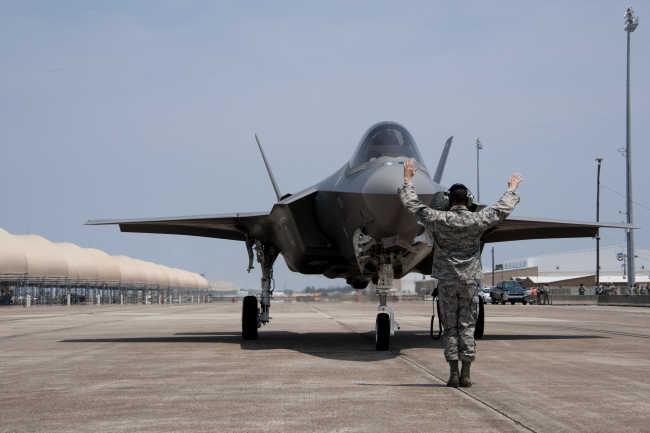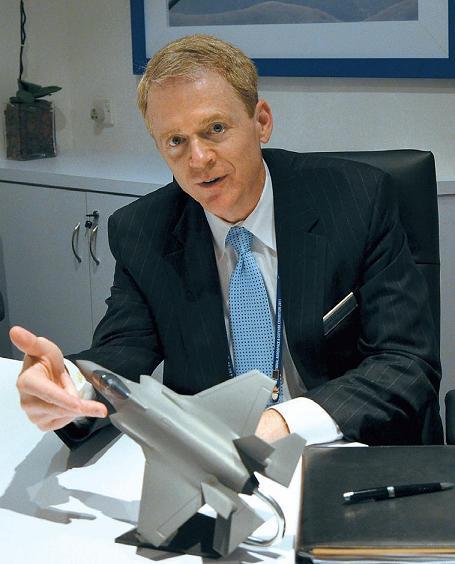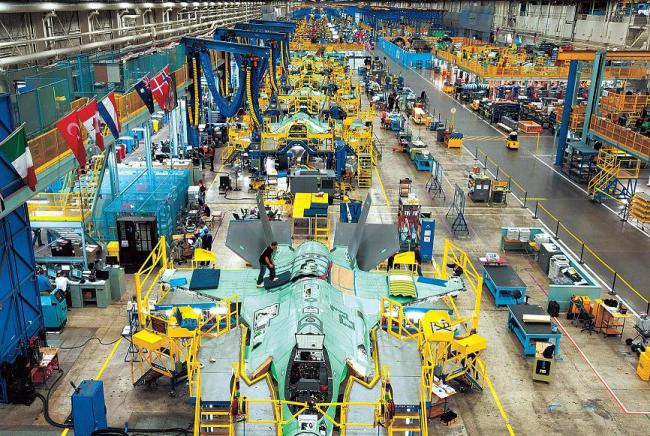
Posted on 03/28/2013 5:44:20 AM PDT by sukhoi-30mki
Seoul faces tough choice in fighter procurement
Lockheed Martin hints at less than $125m price tag for Korea, confident of F-35’s delivery time
FORT WORTH, Texas ― A decade ago, Lockheed Martin’s F-35 was the world’s most sought-after warplane in the making for its all-aspect stealth and next-generation capabilities.
But that confidence has been eroded by the discovery of defects, surging costs and delays in its development.
Skepticism has grown in the U.S. over the $60 billion acquisition program, with some deriding it as a money-guzzling project kept alive partly due to the more than 130,000 U.S. manufacturing jobs that depend on it.
This has spawned concerns in South Korea. In addition to U.S. budgetary problems that could lead to delayed or canceled orders, any trouble in the F-35 program might influence Seoul’s fighter procurement in terms of unit price, capabilities and delivery time.

An F-35A lands at Eglin U.S. Air Force Base in Florida. (USAF)
The F-35’s Air Force variant is one of the three competitors for Seoul’s FX project to purchase a high-end, yet affordable fleet of 60 combat aircraft and start deploying them in 2016.
Boeing’s F-15 Silent Eagle and the Eurofighter Typhoon of the European Aeronautic Defense and Space Company N.V. are the other candidates. Seoul’s choice is expected to be made mid-year.
Dave Scott, director of Lockheed Martin’s F-35 International Business Development, dismissed the deteriorating sentiment over the radar-evading plane, saying the F-35 would be delivered on schedule. He also stressed Seoul would be the “beneficiary” of the investment the U.S. and eight partner nations have made in the program since 2001.
“We have sufficient capability to build and deliver those airplanes (for South Korea). We are in the process of increasing (the production) capacity as we increase orders and deliveries,” he said during an interview with the Korean press contingent at the LM factory in Fort Worth, Texas, last week.

Dave Scott, director of Lockheed Martin’s F-35 International Business Development

Lockheed Martin’s F-35 factory at Forth Worth, Texas (USAF)
Scott also moved to counter the recent news reports over the unit prices.
Some said the unit price for the F-35 would be around $190 million, which would make it impossible for Korea to meet its 8.3 trillion won ($7.48 billion) procurement goal.
“The cost of the A-model (air force version) in the fifth production lot (in 2013) is approximately $125 million. Korea will be buying potentially three years later for their initial buy,” he said.
“So you can have an idea that we are already well below any of the numbers that are being discussed in terms of our actual contract today with the U.S. government.”
The conventional takeoff and landing F-35A is for air force operations, while the F-35B is the Marine Corps’ short take-off and vertical landing variant and the F-35C is the Navy’s carrier-based version. The F-35B and C models are more expensive.
Scott emphasized that 2016, when Korea wants to start bringing in its first batch, would be exactly on the “sweet spot of the cost curve” as mass production in that year would bring down the price.
Within the next several weeks prior to making a price proposal to Seoul, Lockheed will notify Congress of the F-35 program price for Korea. It will not be only a unit price, but a “cost ceiling” that includes support systems, spares and training, he said.
“That is a ceiling amount and the actual (unit) price is a subset ― part of that. The actual amount in the negotiations (with Seoul) will begin at a lower level and work down from there,” he said, urging the press not to mistake it for the airplane price.
One of the crucial challenges to the F-35 program would be the reconsideration by some of the program’s partner nations such as Denmark over their acquisition plans. What worries Korea is the possibility of cancellations by those countries increasing the price.
Scott admitted there would be an impact should there be a “substantial” change in the planned orders by the U.S. government and partner nations, while stressing U.S. and partners’ “commitments” for the F-35 program remain steadfast.
“If there was a change in the 2,443-airplane order (by the U.S.), it will occur many years into the future ― in all likelihoods, long after Korea has purchased the FX airplanes,” he stressed.
The F-35 “Joint Strike Fighter” has been co-developed with the U.S. and eight foreign partners ― Britain, Italy, the Netherlands, Turkey, Canada, Australia, Denmark and Norway ― since 2001.
Over the next three decades, the U.S. military plans to buy 1,763 F-35s for its Air Force and 680 for its Marine Corps and Navy. Lockheed estimates partner nations would buy around 700 F-35s with its forecast of up to 800 orders from other countries including Israel and Japan.
One significant factor for Seoul to consider would be the aircraft’s software and hardware capabilities that have yet to be completed and proven for actual operations.
The F-35 is about one-third through its flight test program. The software is about three years away completion.
“The F-35 is not currently ready for combat operations. It is in the final stage of tests and the initial stage of training,” said Scott. “It will reach combat capability when the U.S. services declare what they call IOC or initial operational capability. That will occur in a few years ― somewhere around 2015 or 2016.”
Other crucial things for Korea to consider are wartime interoperability with its ally U.S. forces and the sustainment cost for its lifecycle ― the next three to four decades. Noting the maintenance cost would be around 15 percent higher than that for the F-16 fighter, Lockheed Martine expressed confidence over these aspects.
“The alliance has some sort of political connotation, but I always think of it in terms of interoperability ― common tactics, operational concepts and communications links. All these things are crucial factors for Korea’s combat capability,” said Randy Howard, the director of the Korea F-35 Campaign.
Stressing the F-35 was at the beginning of its production run, Howard also pointed out that maintenance-wise, the F-35 was at an advantage. But critics have said it is hard to make the cost estimate, as no country has yet used it in operations.
“What a country doesn’t want to do is to be the last country to buy an aircraft because when their production line stops, the cost for spares goes up very significantly,” Howard said.
Technology transfer is another area Seoul has been focusing on in its FX contest as it is seeking to develop an indigenous fighter jet under the “KFX” project to replace its aging F-4 and F-5 fighters.
Along with the KFX, which is about a decade behind schedule, the FX project is an urgent task for the new South Korean government given that its Air Force has already begun experiencing a shortage of warplanes. The winning fighter was to be announced last October, but the decision was deferred amid the presidential election.
The Air Force estimates it may lack some 100 fighters in 2019 when all of the F4s and F5s will be decommissioned. The Air Force believes it needs at least 430 fighter jets of different levels to prepare for possible wartime operations ― some 100 high-end, 200 middle-end and 100 low-end fighters.
Lockheed is seen as less willing to transfer the core technology Seoul needs for its KFX project while the EADS is more keen to share its Eurofighter technology, apparently to overcome its disadvantage as a rare European competitor.
Scott expected his company to be willing to transfer some technology used for the development of the T-50 trainer jet to South Korea when the F-35 is selected.
“If the F-35 is selected, it makes sense. I feel very confident we will allow that (transfer of T-50 technology) to happen. If we are not involved, it is unlikely we would share (the technology,” he said.
With technological assistance from Lockheed Martin, Korea Aerospace Industries, South Korea’s sole aircraft maker, developed the T-50. The two firms are working together to win Washington’s roughly $10 billion project, under which some 350 trainer jets are to be purchased to replace the U.S. Air Force’s aging T-38 trainers.
Dismissing the controversy over what critics call “unstable, unreliable” stealth technology, Lockheed Martin also stressed the regional strategic environment where China, Japan and Russia are transitioning to fifth-generation stealth combat aircraft.
“Don’t forget the threat environment and the advancement being made in the surface-to-air missile systems and the development of the fifth-generation aircraft by China and Russia. (These) present serious problems to the existing fleets of F-15s, F-16s and F-18s,” said Scott.
By Song Sang-ho, Korea Herald correspondent (sshluck@heraldcorp.com)
Heck, forget about the F-35. Go with the Silent Eagle, or the Sukhoi PAK-FA (T-50).
Too much pressure for the Koreans to select the F-35, which is quite bad since the F-15SE would have been a better choice for them, with the savings going towards their own indigenous stealth fighter project. Already the F-15Ks are FAR more than sufficient to anything the North Koreans can wag at them, and as for China the SEs would be sufficient, and any Sino action would most probably bring in other regional powers, with Japan and the US being the most likely participants. Thus, no real need for the F-35.
But it will win this contest.
Heck, in a few more years, the USAF won’t be able to Raptors... And the F-35 doesn’t have the performance for air superiority work. They need to go with real airplane, not the bureaucratic camel that the F-35 has become.
Thus, as long as history repeats itself the F-35 is far more than sufficient. A F-35 type platform in an Iraq type conflict would actually be quite good, with the only role that wouldn't be properly filled being the one of replacing A-10s with the F-35.
However, if the US ever faces off against a near-peer adversary things might be different. Although, it could be argued that the US would never directly confront a near-peer adversary (and vice-versa, China would never directly confront the US), meaning that the point is moot and the F-35 is thus ok. For example, if China ever made real moves in the South China Sea, does anyone really think the US, under whichever president (Democrat or Republican), would really do something about it? I don't think any current or likely future candidate, from either party, would do it. Bush wouldn't, Obama definitely would not, and the likely candidates in 2016 most probably would not.
Thus, maybe getting the F-35 is not such a bad thing. It will suffice against a Gulf War style conflict, would be very effective in a Balkans conflagration, will be flawless in a Libya style situation, and in a Panama scenario it might as well be a Death Star overlooking the moons of Endor! Now, against near-peer adversaries it wouldn't be as shiny, but the US will never have a direct confrontation against China. I am sure there is an active explanation to show why the US decided not to do anything if China ever went against Taiwan. Hence, maybe the F-35 is A-ok.
Tongue in cheek yes, but that might actually be the case.
Always go for the worst case scenario. South Korea should plan like it is going to face late model Sukhois, up to and including the PAK-FA.
Of course, given their capabilities in electronics, I am surprised the South Koreans not building a UCAV. Given the capabilities of some missiles (like the AMRAAM) all you need is a radar with the proper fire control capabilities, and a bundle of missiles. Get in range, acquire the targets, distribute your shots, let fly, and go home... Think of it as a combination flying SAM battery and distributed sensor system. You could run your air battle from a bunker.
Disclaimer: Opinions posted on Free Republic are those of the individual posters and do not necessarily represent the opinion of Free Republic or its management. All materials posted herein are protected by copyright law and the exemption for fair use of copyrighted works.